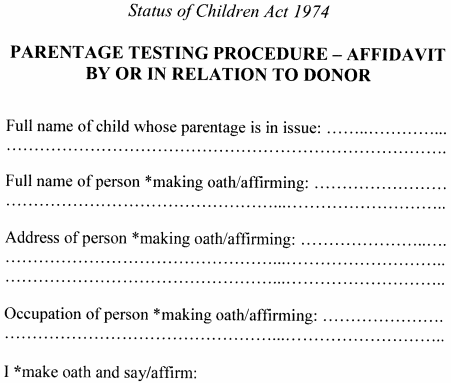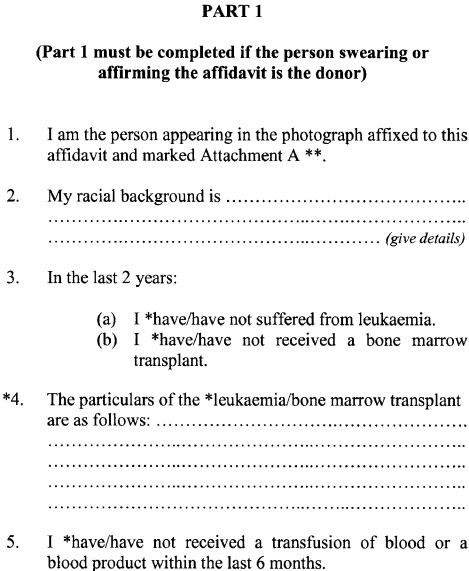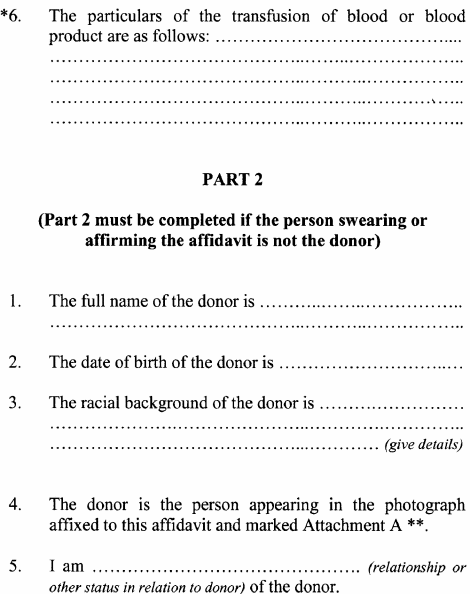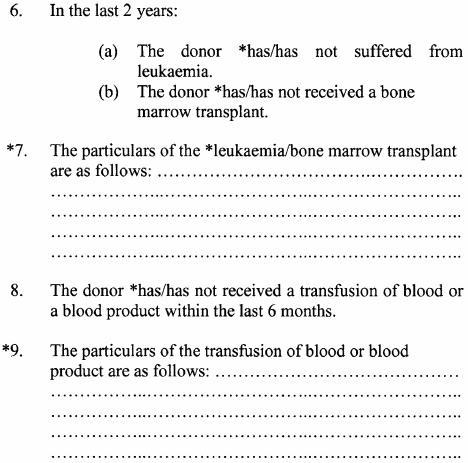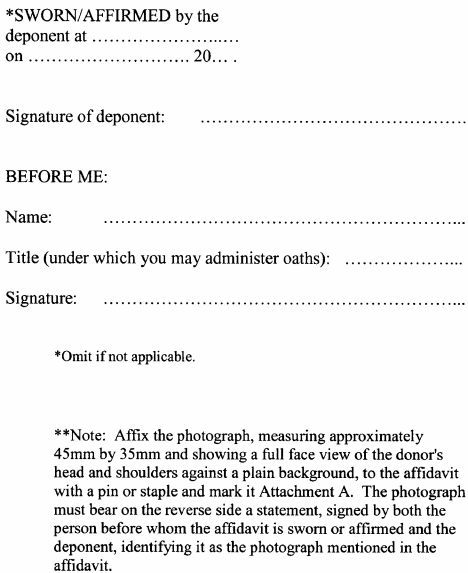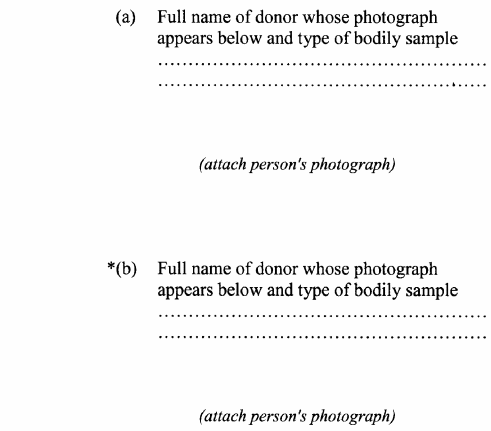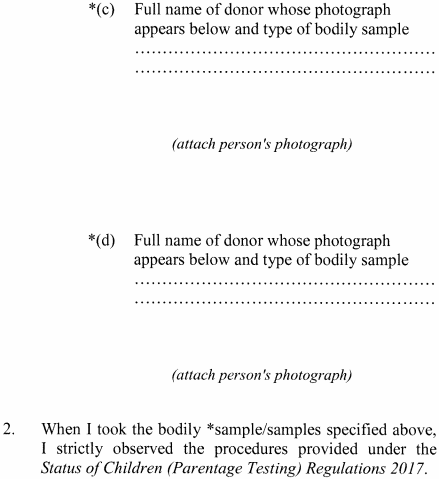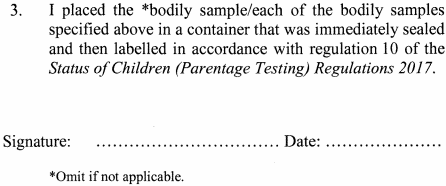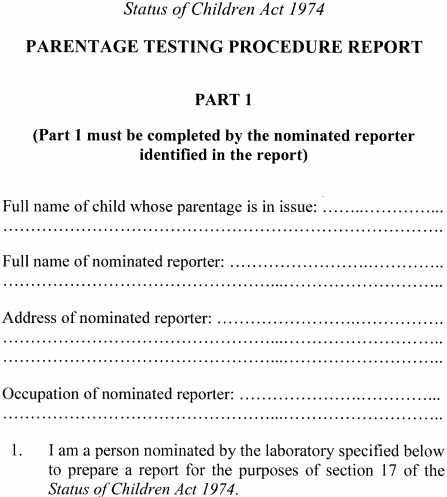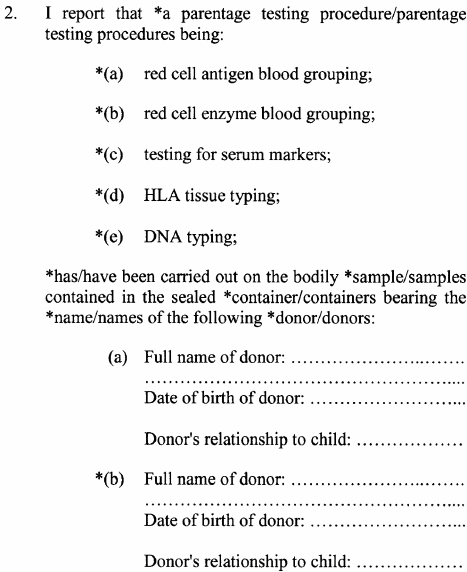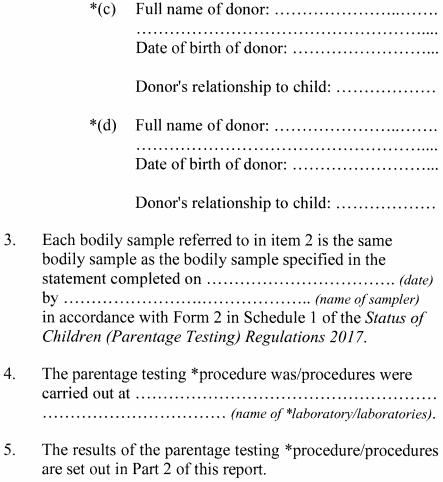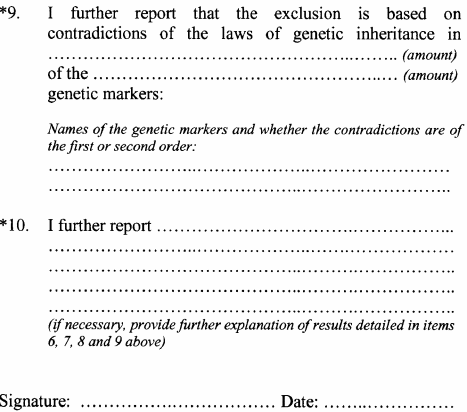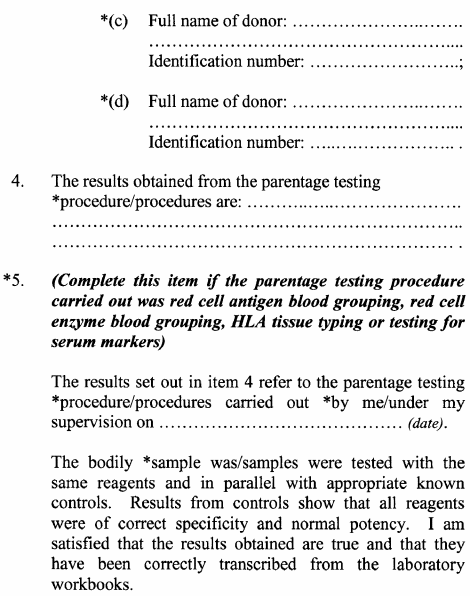Status of Children (Parentage Testing) Regulations 2017
I, the Governor in and over the State of Tasmania and its Dependencies in the Commonwealth of Australia, acting with the advice of the Executive Council, make the following regulations under the Status of Children Act 1974 .
12 June 2017C. WARNER
Governor
By Her Excellency's Command,
MATTHEW GROOM
Minister for State Growth acting for and on behalf of the Minister for Justice
PART 1 - Preliminary
These regulations may be cited as the Status of Children (Parentage Testing) Regulations 2017 .
These regulations take effect on 28 June 2017.
In these regulations, unless the contrary intention appears –Act means the Status of Children Act 1974 ;bodily sample includes, but is not limited to, a sample of human blood;child means a person who has not attained the age of 18 years;DNA means deoxyribonucleic acid;donor means the person in relation to whom an order is made;guardian, in relation to a donor, means –(a) a person who is a guardian, manager, administrator or attorney of the donor under a law of –(i) the State that applies to the donor; or(ii) another State or a Territory that applies to the donor; or(b) a person who is responsible for the long-term care, welfare and development of the donor;HLA means human leucocyte antigen;laboratory means a laboratory that is accredited by NATA for the purpose of carrying out parentage testing procedures;NATA means the National Association of Testing Authorities, Australia;order means an order made under section 13 of the Act requiring a parentage testing procedure to be carried out;parent, in relation to a child, means –(a) a person who has parental responsibility for the child; or(b) a guardian of the child; or(c) a foster parent of the child; or(d) a person who generally acts in the place of a person who has parental responsibility for the child and has done so for a significant length of time;parental responsibility means all the duties, powers, responsibilities and authority which, by law, parents have in relation to their children;sampler means a person, referred to in regulation 6 , who takes a bodily sample from a donor;testing means the carrying out, or any part of the carrying out, of a parentage testing procedure.
PART 2 - Parentage Testing Procedures
4. Parentage testing procedures
For the purposes of the definition of "parentage testing procedure" in section 11 of the Act, the following medical procedures are prescribed medical procedures:(a) red cell antigen blood grouping;(b) red cell enzyme blood grouping;(c) HLA tissue typing;(d) testing for serum markers;(e) DNA typing.
PART 3 - Carrying out of Parentage Testing Procedures
This Part applies to the carrying out of parentage testing procedures under Part IV of the Act.
A person must not take a bodily sample from a donor unless the person is –(a) a medical practitioner; or(b) employed by a hospital, pathology practice, parentage testing practice or medical practitioner for the purpose of taking a bodily sample from a donor.
7. Provision of information by donors
(1) A sampler must not take a bodily sample from a donor unless –(a) immediately before the sampler takes the bodily sample, the donor has completed an affidavit in accordance with Form 1 in Schedule 1 to which is attached a recent photograph of the donor; and(b) the donor provides the sampler with –(i) the completed affidavit to which is attached the recent photograph; and(ii) an additional copy of that recent photograph.(2) For the purposes of subregulation (1)(a) and (b) , the recent photograph of the donor must measure approximately 45 millimetres by 35 millimetres, and must show a full-face view of the donor's head and shoulders against a plain background.(3) If the donor is a child, the affidavit referred to in subregulation (1)(a) is to be completed by a person who is a parent of the child.(4) If the donor is a person who, by reason of disability, is unable to make reasonable judgments in relation to his or her personal circumstances, the affidavit referred to in subregulation (1)(a) is to be completed by a person who is a guardian of the donor.
8. Collection of blood samples
(1) A sampler must not take a sample of blood from a donor with a needle or syringe, unless the needle or syringe –(a) has not been used previously for any purpose; and(b) has been sterilised; and(c) is disposable.(2) Before taking a sample of blood from a donor, the sampler is to ensure that the area of the donor's skin into which the needle is to be inserted to withdraw the blood has been cleaned with an antiseptic.
9. Collection of bodily samples for DNA typing
(1) This regulation applies to the taking of a bodily sample, other than a bodily sample that is a sample of blood, from a donor for the purposes of a parentage testing procedure that is DNA typing.(2) A sampler must not take a bodily sample from a donor with a swab, unless the swab –(a) has not been used previously for any purpose; and(b) has been sterilised.(3) A sampler must not take a skin scraping or a hair root from a donor with an implement unless the implement has been sterilised.
10. Containers to be sealed and labelled
(1) If a sampler takes a bodily sample from a donor, the sampler must ensure that the bodily sample is placed in a container that complies with subregulation (2) –(a) immediately after the bodily sample is taken; and(b) subject to subregulations (4) and (5) , in the presence of the donor.(2) For the purposes of subregulation (1) , a container –(a) must not have been used previously for any purpose; and(b) must be sealed in a way that, if it were opened after being sealed, that fact of opening would be evident on inspection of the container; and(c) must have a label, on which the following information is written in ink, securely attached to it:(i) the full name of the donor;(ii) the date of birth of the donor;(iii) the gender identity of the donor;(iv) the date on which and time at which the bodily sample was taken; and(d) must be labelled in a way that, if the writing on the label were later obscured, altered or erased, that would be evident on inspection of the label.(3) After the label referred to in subregulation (2)(c) is completed and attached to the container it must be signed, in ink, by the sampler and, subject to subregulations (4) and (5) , the donor.(4) If the donor is a child –(a) the sampler is to comply with subregulation (1) in the presence of a parent of the child; and(b) for the purposes of subregulation (3) , a parent of the child is to sign the label instead of the donor.(5) If the donor is a person who, by reason of disability, is unable to make reasonable judgments in relation to his or her personal circumstances –(a) the sampler is to comply with subregulation (1) in the presence of a person who is a guardian of the donor; and(b) for the purposes of subregulation (3) , a person who is a guardian of the donor is to sign the label instead of the donor.(6) In this regulation –gender identity means the gender-related identity, appearance or mannerisms or other gender-related characteristics of a person (whether by way of medical intervention or not), with or without regard to the person’s designated sex at birth.
As soon as practicable after a sampler takes a bodily sample from a donor, the sampler must –(a) complete a statement in accordance with Form 2 in Schedule 1 ; and(b) affix the photograph of the donor, in the sampler's possession under regulation 7(1)(b)(ii) , to the statement; and(c) sign his or her name partly on the photograph and partly on the statement in a way that, if the photograph were later removed from the statement, the removal would be evident from inspection of the statement.
12. Packing and storage requirements
(1) A sampler must ensure that a bodily sample is packed, stored and transported to a laboratory for testing in a manner that –(a) will preserve the integrity of the bodily sample; and(b) will ensure that the testing of the bodily sample will produce the same results as would have been obtained if the bodily sample had been tested immediately after collection.(2) A sampler must ensure that the following documents are sent to the laboratory with a bodily sample:(a) the affidavit in his or her possession in accordance with regulation 7(1)(a) ;(c) the statement completed under regulation 11(a) .
13. Laboratory testing of bodily samples
(1) A laboratory to which a bodily sample is sent for testing is to ensure that –(a) the testing is undertaken in accordance with standards of practice that entitle the laboratory to be accredited by NATA for the purpose of carrying out parentage testing procedures; and(b) the testing is completed –(i) if the proposed procedure is red cell antigen blood grouping, red cell enzyme blood grouping or testing for serum markers, within 6 days after the bodily sample is taken; or(ii) if the proposed procedure is HLA tissue typing, within 3 days after the bodily sample is taken; or(iii) if the proposed procedure is DNA typing, within a reasonable time after the bodily sample is taken.(2) If the proposed procedure is red cell enzyme blood grouping or testing for serum markers, subregulation (1)(b)(i) is complied with if –(a) the testing is completed within 6 days after the bodily sample is taken from the donor; or(b) a dried sample of the bodily sample to be tested is prepared within those 6 days.
(1) For the purposes of section 17(1) of the Act, the prescribed form in which a report is to be made is in accordance with Form 3 in Schedule 1 .(2) If a report is not completed in accordance with this regulation it is of no effect.
PART 4 - Miscellaneous
15. Prescribed overseas jurisdictions
For the purposes of the definition of "prescribed court" in section 2 of the Act, New Zealand and the United Kingdom are prescribed overseas jurisdictions.
SCHEDULE 1 - Forms
Form 1
Form 2
Form 3
Displayed and numbered in accordance with the Rules Publication Act 1953.
Notified in the Gazette on 21 June 2017


